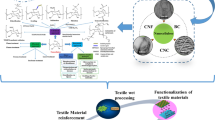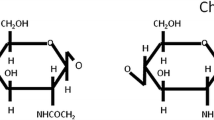Abstract
This study investigates the synthesis, characterization, and application of copper oxide nanoparticles (CuO NPs) for enhancing the shelf life of strawberries and exploring adjacent plasmonic phenomena. Utilizing both sol–gel and precipitation methods, the CuO NPs were synthesized, characterized by X-ray diffraction (XRD) and scanning electron microscopy (SEM), and exhibited high purity as confirmed by energy-dispersive spectroscopy (EDS). SEM analysis showed that nanoparticles created using the precipitation method were uniformly spherical and sized between 30 and 70 nm. BET analysis revealed a surface area of 58.76 m2/g, enhancing their antimicrobial effectiveness. The application phase involved coating strawberries with CuO NP–infused gelatin and glycerol solutions to assess their impact on fruit preservation. Increased concentrations of CuO NPs correlated with significant enhancements in preservation effectiveness, extending shelf life up to 27 days without spoilage. Additionally, the interaction of CuO NPs with light, despite lacking surface plasmon resonance, provides insightful implications for designing nanocomposites with improved functionalities for food packaging. This study underscores the potential of CuO NPs as promising nanomaterials for food preservation, offering a novel approach to reduce food waste and enhance food safety through innovative nanopackaging solutions.
Graphical Abstract













Similar content being viewed by others
Data Availability
No datasets were generated or analyzed during the current study.
References
Hulla J, Sahu S, Hayes A (2015) Nanotechnology: History and future. Human Experimental Toxicol 34:1318–1321. https://doi.org/10.1177/0960327115603588
Shakti N, Mandal T, Das NM, Roy D, Sunder S, Kumar S, Pal R (2024) Growth and electrochemical properties of CuO nanowires-ZnO microrods composite. Hybrid Advances 5:100124. https://doi.org/10.1016/j.hybadv.2023.100124
Bayda S, Adeel M, Tuccinardi T, Cordani M, Rizzolio F (2019) The History of Nanoscience and Nanotechnology: From Chemical-Physical Applications to Nanomedicine. Molecules 25. https://doi.org/10.3390/molecules25010112
Shatkin JA (2017) Nanotechnology: Health and environmental risks, second edition. CRC Press
Abbasi A, Khojasteh H, Keihan AH, Adib K, Sobhani-Nasab A, Rahimi-Nasrabadi M (2021) Co-precipitation synthesis of Ag-doped NiCr2O4 nanoparticles: investigation of structural, optical, magnetic, and photocatalytic properties. J Mater Sci: Mater Electron 32:1413–1426
Mohammadi-Aghdam S, Mizwari ZM, Khojasteh H (2023) Visible light photoactivity of the Cu doped TiO2/Yb2O3 nanocomposite for degradation of acid red 88 solution. J Sol-Gel Sci Technol 108:127–135
Zhian H, Khojasteh H, azimi c (2023) Eco-Friendly Hydrothermal Synthesis of CuO Nanoparticles using Natural Materials as Reducing and Capping Agents. Iranian J Chemistry Chem Eng. https://doi.org/10.30492/ijcce.2023.2002779.6038
Aspoukeh PK, Barzinjy AA, Hamad SM (2022) Synthesis, properties and uses of ZnO nanorods: a mini review. International Nano Letters 12:153–168
Basavegowda N, Somu P, Shabbirahmed AM, Gomez LA, Thathapudi JJ (2022) Bimetallic p-ZnO/n-CuO nanocomposite synthesized using Aegle marmelos leaf extract exhibits excellent visible-light-driven photocatalytic removal of 4-nitroaniline and methyl orange. Photochem Photobiol Sci 21:1357–1370. https://doi.org/10.1007/s43630-022-00224-0
Aspoukeh PK, Barzinjy AA, Hamad SM (2023) A novel approach to the green synthesis of zinc oxide nanorods using Thymus kotschyanus plant extract: effect of ammonium hydroxide and precursor concentration. Nano Express 4:045001
Basavegowda N, Somai Magar KB, Mishra K, Lee YR (2014) Green fabrication of ferromagnetic Fe3O4 nanoparticles and their novel catalytic applications for the synthesis of biologically interesting benzoxazinone and benzthioxazinone derivatives. New J Chem 38:5415–5420. https://doi.org/10.1039/C4NJ01155D
Mishra K, Basavegowda N, Lee YR (2016) Access to enhanced catalytic core–shell CuO–Pd nanoparticles for the organic transformations. RSC Adv 6:27974–27982. https://doi.org/10.1039/C6RA03883B
Khan FA (2020) Synthesis of Nanomaterials: Methods & Technology. In: Khan FA, editor. Applications of Nanomaterials in Human Health. Singapore: Springer Singapore; p. 15-21. https://doi.org/10.1007/978-981-15-4802-4_2
Xie P, Cao X, Lin Z (2017) Javanmard MJLoaC. Top-down fabrication meets bottom-up synthesis for nanoelectronic barcoding of microparticles 17:1939–1947
Patil N, Bhaskar R, Vyavhare V, Dhadge R, Khaire V (2021) Patil YJIJoCPR. Overview on methods of synthesis of nanoparticles 13:11–16
Baig N, Kammakakam I, Falath W (2021) Nanomaterials: a review of synthesis methods, properties, recent progress, and challenges. Maters Adv 2:1821–1871. https://doi.org/10.1039/D0MA00807A
Jolivet J-P, Henry M, Livage J (2000) Metal oxide chemistry and synthesis: from solution to solid state: Wiley-Blackwell
Grigore ME, Biscu ER, Holban AM, Gestal MC, Grumezescu AM (2016) Methods of Synthesis, Properties and Biomedical Applications of CuO Nanoparticles. Pharmaceuticals 9:75. https://doi.org/10.3390/ph9040075
Narsinga Rao G, Yao YD, Chen JW (2009) Evolution of size, morphology, and magnetic properties of CuO nanoparticles by thermal annealing. J Appl Phys 105. https://doi.org/10.1063/1.3120785
Gaur J, Kumar S, Pal M, Kaur H, Batoo KM, Momoh JO (2024) Current trends: zinc oxide nanoparticles preparation via chemical and green method for the photocatalytic degradation of various organic dyes. Hybrid Advances 5:100128. https://doi.org/10.1016/j.hybadv.2023.10012
Aparna Y, Rao KE, Subbarao PS (2012) Synthesis and characterization of CuO nano particles by novel sol-gel method. Proceedings of the 2nd International Conference on Environment Science and Biotechnology. IACSIT Press Singapore. 156–160
Chippada MLVP, Sailaja BBV, Siva Rao T, Divya G, Nayak SR, Manogna BS, Jaishree G (2023) Structural modification of nano titania by doping with barium and copper – impact on photocatalysis: applications in degradation of dye and pathogens. Hybrid Advances 3:100033. https://doi.org/10.1016/j.hybadv.2023.100033
Tran TH, Nguyen VT (2014) Copper Oxide Nanomaterials Prepared by Solution Methods, Some Properties, and Potential Applications: A Brief Review. Int Scholarly Res Notices 2014:856592. https://doi.org/10.1155/2014/856592
Singh J, Kaur G, Rawat MJJBN (2016) A brief review on synthesis and characterization of copper oxide nanoparticles and its applications. J Bioelectron Nanotechnol 1:1. https://doi.org/10.13188/2475-224X.1000003
Adam RE, Pozina G, Willander M, Nur O (2018) Synthesis of ZnO nanoparticles by co-precipitation method for solar driven photodegradation of Congo red dye at different pH. Photonics Nanostructures Fundamentals App 32:11–18. https://doi.org/10.1016/j.photonics.2018.08.005
Yadav B, Sikarwar S, Bhaduri A, Kumar PJS (2015) Synthesis, characterization and development of opto-electronic humidity sensor using copper oxide thin film. Int Adv Res J Sci Eng Technol 2. https://doi.org/10.17148/IARJSET.2015.21122
Basavegowda N, Baek K-H (2021) Synergistic antioxidant and antibacterial advantages of essential oils for food packaging applications. Biomolecules 11:1267
Ghosh N, Sen S, Biswas G, Singh LR, Haldar PK (2021) Synthesis and characterization of CuO nanoparticles and CuO/PVA-PVP nanocomposites: adsorption activity for malachite green (MG) dye and antibacterial property in wastewater treatment. https://doi.org/10.21203/rs.3.rs-1089880/v1
Syame SM, Mohamed WS, Mahmoud R, Omara ST (2017) Synthesis of copper-chitosan nanocomposites and its application in treatment of local pathogenic isolates bacteria. Oriental Journal of Chemistry. https://doi.org/10.13005/ojc/330632
Dulta K, Ağçeli GK, Jasrotia R, Chandan G, Chauhan PK (2021) Multifunctional CuO nanoparticles with enhanced photocatalytic dye degradation and antibacterial activity. https://doi.org/10.21203/rs.3.rs-346220/v1
Reidy B, Haase A, Luch A, Dawson KA, Lynch I (2013) Mechanisms of silver nanoparticle release, transformation and toxicity: a critical review of current knowledge and recommendations for future studies and applications. Materials. https://doi.org/10.3390/ma6062295
Souza VGL, Rodrigues C, Valente S, Pimenta C, Pires JRA, Alves MM, Santos C, Coelhoso IM, Fernando AL (2020) Eco-friendly ZnO/chitosan bionanocomposites films for packaging of fresh poultry meat. Coatings. https://doi.org/10.3390/coatings10020110
Fathi N, Hoseinipanah SM, Alizadeh Z, Assari MJ, Moghimbeigi A, Mortazavi M, Hosseini M, Bahmanzadeh M (2018) The effect of silver nanoparticles on the reproductive system of adult male rats: a morphological, histological and DNA integrity study. Adv Clin Exp Med. https://doi.org/10.17219/acem/81607
Fomina M, Hillier SJ, Charnock J, Melville K, Alexander IJ, Gadd GM (2005) Role of oxalic acid overexcretion in transformations of toxic metal minerals by Beauveria caledonica. Appl Environ Microbiol. https://doi.org/10.1128/aem.71.1.371-381.2005
Bokov DO, Jalil AT, Chupradit S, Suksatan W, Ansari MJ, Shewael IH, Valiev GH, Kianfar E (2021) Nanomaterial by sol-gel method: synthesis and application. Adv Mater Sci Eng. https://doi.org/10.1155/2021/5102014
Bienholz A, Schwab F, Claus P (2010) Hydrogenolysis of glycerol over a highly active CuO/ZnO catalyst prepared by an oxalate gel method: influence of solvent and reaction temperature on catalyst deactivation. Green Chem. https://doi.org/10.1039/b914523k
Luna IZ, Hilary LN, Chowdhury AS, Gafur M, Khan N, Khan RA (2015) Preparation and characterization of copper oxide nanoparticles synthesized via chemical precipitation method. Open Access Library Journal 2:1–8
Gvozdenko AA, Siddiqui SA, Blinov AV, Golik AB, Nagdalian AA, Maglakelidze DG, Statsenko EN, Pirogov MA, Blinova AA, Sizonenko MN, Simonov AN, Zhukov RB, Kolesnikov RO, Ibrahim SA (2022) Synthesis of CuO nanoparticles stabilized with gelatin for potential use in food packaging applications. Sci Rep 12:12843. https://doi.org/10.1038/s41598-022-16878-w
Duncan TV (2011) Applications of nanotechnology in food packaging and food safety: barrier materials, antimicrobials and sensors. J Colloid Interface Sci. https://doi.org/10.1016/j.jcis.2011.07.017
Primožič M, Knez Ž, Leitgeb M (2021) (Bio)nanotechnology in food science—food packaging. Nanomaterials. https://doi.org/10.3390/nano11020292
Kraśniewska K, Galus S, Gniewosz M (2020) Biopolymers-based materials containing silver nanoparticles as active packaging for food applications–a review. Int J Mol Sci. https://doi.org/10.3390/ijms21030698
Acknowledgements
We would like to express our sincere gratitude to the Scientific Research Center of Soran University for their support and assistance throughout the course of this research project. Their commitment to promoting scientific research and fostering an environment of academic excellence has been instrumental in the successful completion of this study. We extend our appreciation to the staff and faculty members of the Scientific Research Center for their valuable guidance, technical expertise, and access to research facilities.
Author information
Authors and Affiliations
Contributions
Hossein Khojasteh contributed to the conceptualization of the study, formulation of the research design, and oversight of the entire research project. Mihraban Mawlan Mohammed, Hezha Nuri Ibrahim, and Sarezh Mzafar Sleman played a key role in the synthesis and characterization of CuO NPs, including the application of various methods such as sol–gel and precipitation.
Peyman Aspoukeh and Kamran Heydaryan contributed significantly to the experimental work, data collection, and analysis, particularly in the examination of the impact of CuO NPs on strawberry preservation. Mohammad-Peyman Mazhari was involved in the application phase of the study, specifically in the coating of strawberries with CuO NP–infused solutions and the evaluation of shelf life.
All authors actively participated in the drafting and critical review of the manuscript. Hossein Khojasteh and Peyman Aspoukeh were particularly involved in the writing of the original draft, while Mohammad-Peyman Mazhari contributed to the manuscript’s review and editing process. The final version of the manuscript was approved by all authors.
Corresponding author
Ethics declarations
Ethical Approval
This declaration is not applicable.
Competing interests
The authors declare no competing interests.
Additional information
Publisher's Note
Springer Nature remains neutral with regard to jurisdictional claims in published maps and institutional affiliations.
Rights and permissions
Springer Nature or its licensor (e.g. a society or other partner) holds exclusive rights to this article under a publishing agreement with the author(s) or other rightsholder(s); author self-archiving of the accepted manuscript version of this article is solely governed by the terms of such publishing agreement and applicable law.
About this article
Cite this article
Khojasteh, H., Heydaryan, K., Aspoukeh, P. et al. Characterization and Application of CuO Nanoparticles in Gelatin-Glycerol Coatings for Enhanced Shelf Life of Strawberries. Plasmonics (2024). https://doi.org/10.1007/s11468-024-02345-x
Received:
Accepted:
Published:
DOI: https://doi.org/10.1007/s11468-024-02345-x




